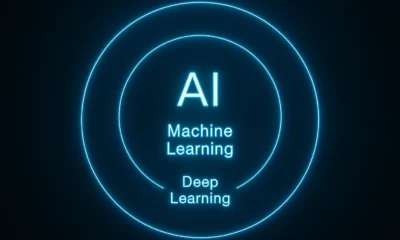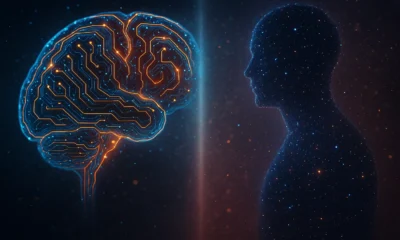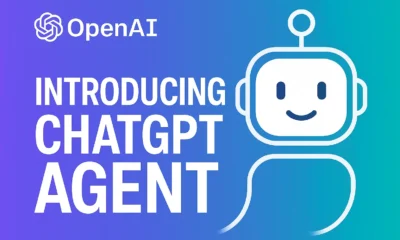AI News & Updates
AI-Powered Malware: Discover the Ultimate Evolving Threat
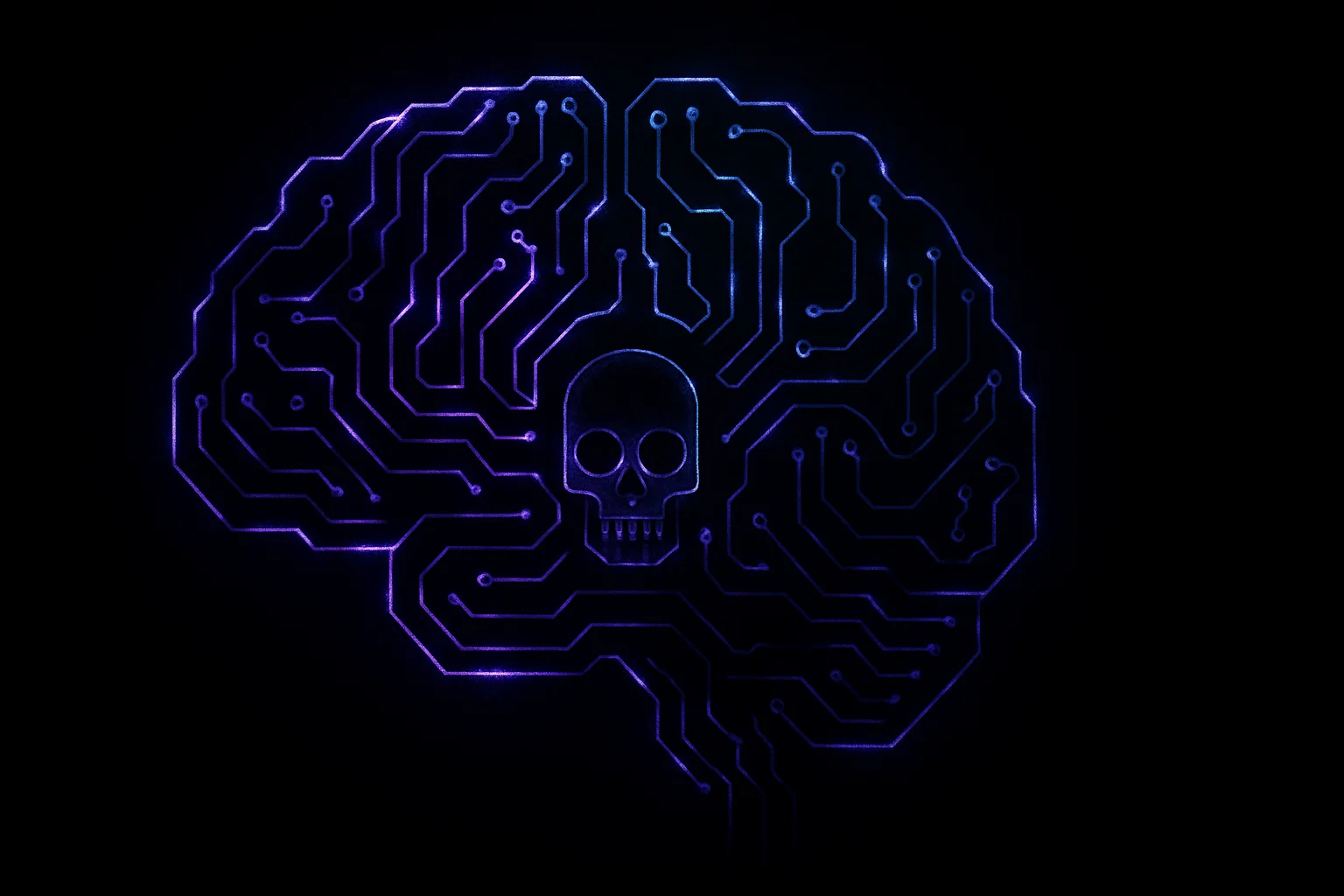
Malware, the invisible enemy of our digital age, is constantly evolving. What began as harmless pranks has morphed into a multi-billion dollar criminal enterprise, and its next phase is already taking shape. The rise of sophisticated threats means understanding the evolution from simple viruses to the looming reality of AI-powered malware is more critical than ever. This journey from the past, through the present, and into the future reveals a chilling trajectory that demands our attention and vigilance.
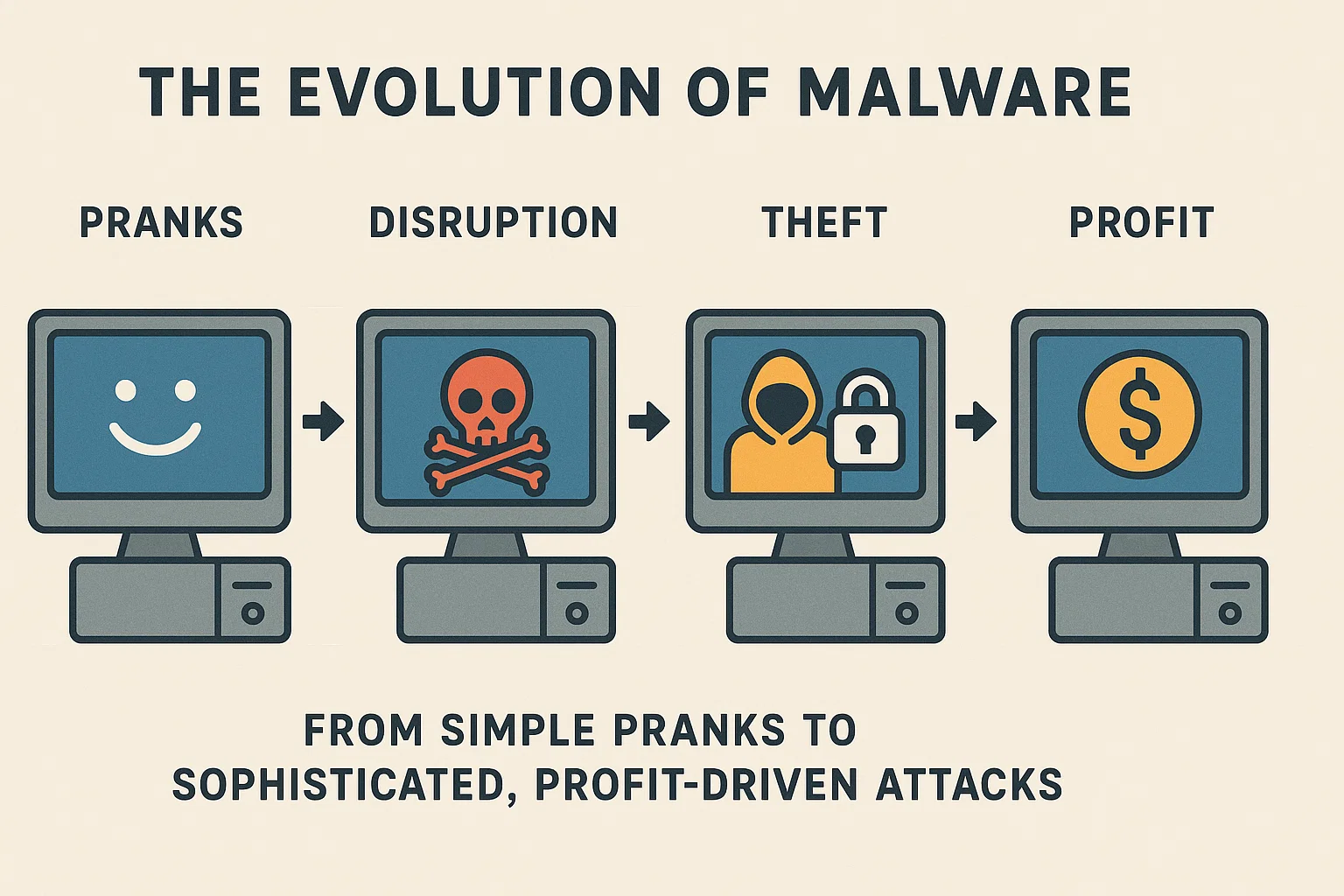
The Past: From Mischief to Mayhem
In the early days of the internet, malware wasn’t about financial gain. It was primarily driven by curiosity, ego, and the desire to cause disruption. These early forms were often loud, visible, and built a reputation for their creators through notoriety rather than profit.
Viruses & Worms
The first threats many of us encountered were viruses and worms. A virus, like the infamous “ILOVEYOU” virus of 2000, required user interaction to spread—typically by tricking someone into opening a malicious email attachment. In contrast, a worm, such as the 1988 Morris Worm, was self-replicating and could spread across networks on its own by exploiting system vulnerabilities.
Trojans and Other Early Threats
The concept of deception became more advanced with Trojans. Named after the mythical Trojan Horse, this malware masquerades as legitimate software to trick users into installing it. The “Zeus” banking Trojan (2007) was a prime example, stealing credentials through a man-in-the-browser attack. Other early forms included:
- Boot Sector Malware: Spread via floppy disks (e.g., Michelangelo, 1991), this type is rare today.
- Macro Viruses: Embedded in office documents (e.g., Concept, 1995), they exploited the scripting capabilities within programs like Microsoft Word.
- Rootkits: Designed to hide their presence and other malicious activity deep within a computer’s operating system.
The Present: The Age of Profitable Malware
Today’s malware is smarter, stealthier, and overwhelmingly motivated by one thing: profit. The game has changed from disruption to a sophisticated criminal industry.

Ransomware
Ransomware is arguably the most significant threat today. It generally falls into two categories:
- Encryption Ransomware: This type, like the notorious WannaCry (2017), encrypts your files and demands a ransom payment for the decryption key.
- Extortion Ransomware: This type steals your sensitive data and threatens to release it publicly unless you pay up.
Infostealers, RATs, and IoT Threats
Beyond ransomware, several other malicious tools are actively used to generate illicit profits:
- Infostealers: Their sole purpose is to steal information, such as passwords, personal data (PII), and financial details.
- Remote Access Trojans (RATs): RATs like the sophisticated Pegasus spyware give an attacker complete remote control of a device, allowing them to access the camera, microphone, and GPS, and monitor all activity.
- IoT Malware: With the explosion of Internet of Things devices, malware like the Mirai botnet can hijack thousands of insecure devices (like security cameras and DVRs) to launch massive Distributed Denial of Service (DDoS) attacks.
- Cryptojackers: This malware silently hijacks your computer’s resources to mine cryptocurrency for the attacker, draining your system’s performance and increasing your power bill.
The Future: The Rise of AI-Powered Malware
The next frontier for cyber threats is undoubtedly the integration of Artificial Intelligence. AI-powered malware represents a paradigm shift, creating threats that are autonomous, adaptive, and incredibly difficult to defend against.
Creation & Execution
AI is set to revolutionize both the creation and execution of malware. A recent study revealed that OpenAI’s GPT-4 model could create functional exploit code for known vulnerabilities (CVEs) in 87% of cases. This dramatically lowers the barrier to entry for would-be cybercriminals. In the future, AI-powered malware will intelligently execute attacks by:
- Decision-Making: Autonomously deciding which targets are most valuable or vulnerable.
- Targeting: Identifying the softest entry points into a network or system.
- Evasion: Adapting its code and behavior in real-time (an advanced form of polymorphic malware) to evade even the most sophisticated detection tools.
For more on how AI is changing our world, check out our articles on Future of AI & Trends.
Deepfakes as a Weapon
AI’s ability to create deepfakes adds a terrifying new dimension to social engineering. Imagine receiving a perfectly realistic voice message or video call from your CEO instructing you to make an urgent, high-value wire transfer. This is no longer science fiction; it’s an emerging threat that leverages AI to bypass human trust and security protocols.
We will be diving deeper into deepfake technology in a future post.
Your Defense: Essential Actions to Protect Against Evolving Malware
While the future may seem daunting, there are concrete steps you can take today to build a strong defense. Protecting yourself and your organization requires a layered, proactive approach.
- Patch Your Systems: This is the single most important action. Many attacks exploit known vulnerabilities for which a patch is already available. Keep your operating system, applications, and all software up to date.
- Train and Educate: Awareness is key. Train yourself and your employees to recognize phishing emails, suspicious links, and the dangers of downloading untrusted software.
- Use Security Tools: Employ a combination of modern antivirus (AV) and Endpoint Detection and Response (EDR) solutions. These tools have evolved from simple signature-based detection to behavior-based analysis to catch newer threats.
- Maintain Backups: Assume failure will happen. Regularly back up your important data and, crucially, test your restore process. Ensure your backups are isolated so they cannot be infected by ransomware.
- Limit Admin Access: Follow the principle of least privilege. Users should not have administrative rights for daily tasks. This limits the damage malware can do if a user’s account is compromised.
- Deploy Firewalls: Use both personal firewalls on individual machines and network-level firewalls to control incoming and outgoing traffic, which can block malicious communications.
- Implement SIEM: For organizations, a Security Information and Event Management (SIEM) system provides a holistic view of your entire network, helping to correlate events and detect attacks that might otherwise go unnoticed.
The journey of malware from digital graffiti to profit-driven ransomware and now towards AI-powered malware is a clear indicator that threats will only become more sophisticated. As attackers evolve their methods from pranks to profit to potential cyber weapons, our defenses must evolve too. By staying curious, remaining updated on the latest threats, and implementing robust security practices, we can build the resilience needed to stay safe in this ever-changing digital landscape.
AI News & Updates
Gemini 3 Revealed: Discover The AI Beast Crushing All Benchmarks
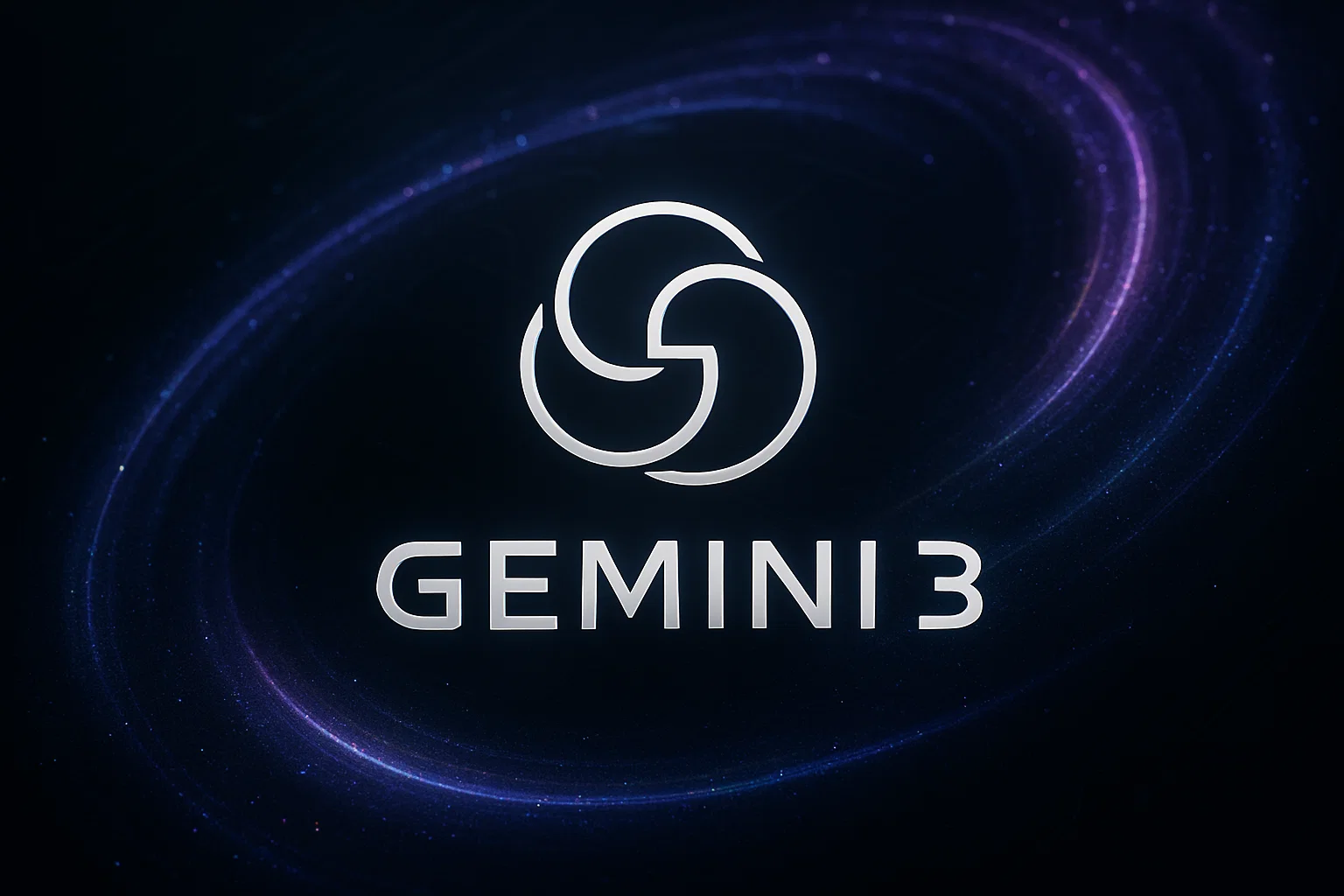
Google has just rolled out its new flagship model, and it’s an absolute beast. The new Gemini 3 isn’t just a minor incremental update; it’s a significant leap forward that genuinely earns the “3” in its name. After an early look at its capabilities, it’s clear that this model is set to redefine the standards of AI performance across the board. From complex reasoning to advanced agentic tasks, let’s dive into what makes this release so monumental.
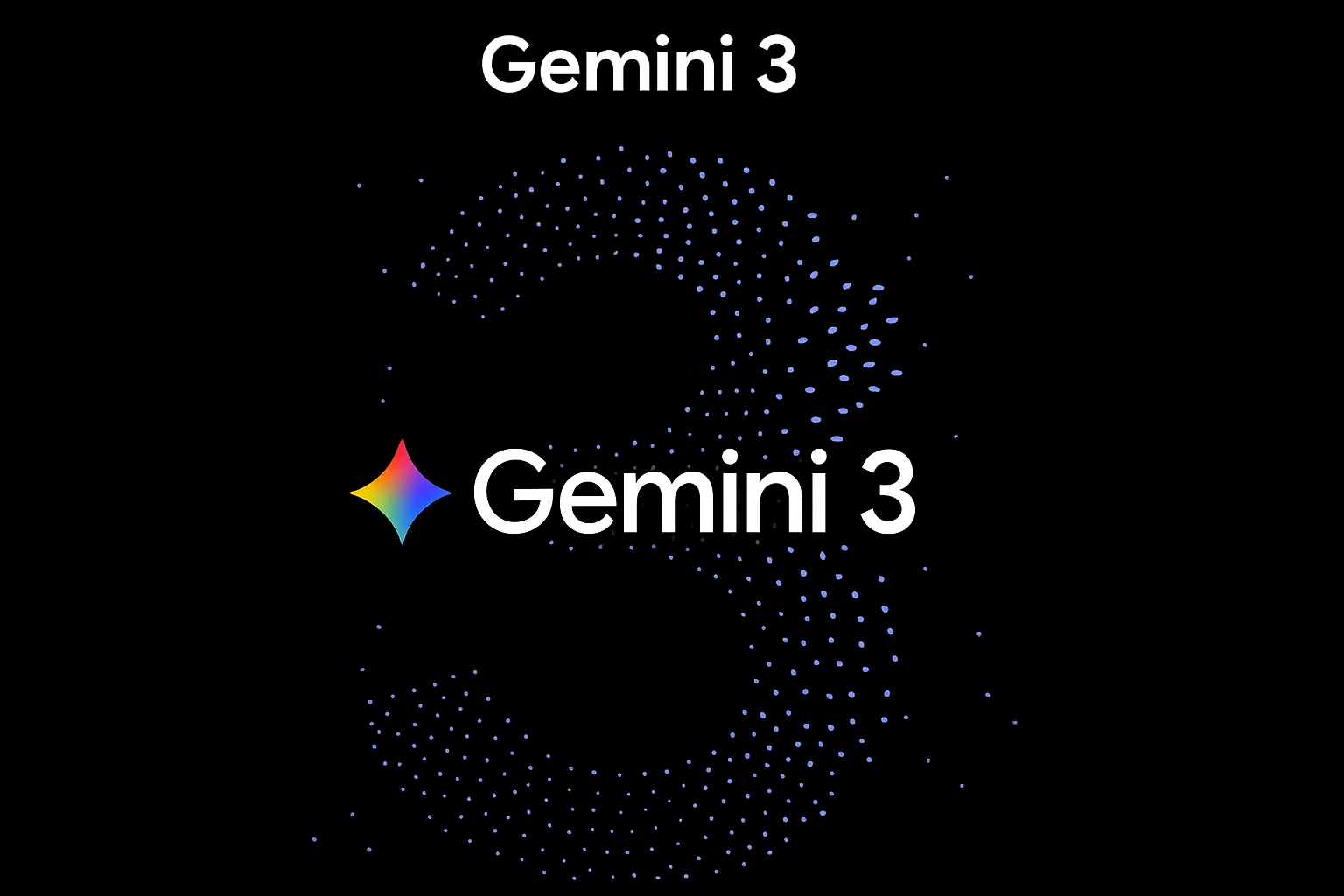
Where Can You Access Gemini 3?
Starting today, Google is shipping Gemini 3 at a massive scale. You can now try it out across a suite of Google products, making it immediately accessible for both general users and developers. The new model is live in:
- The Gemini app
- AI Studio
- Vertex AI
Additionally, you will see Gemini 3 integrated into the AI Mode in Search, promising more complex reasoning and new dynamic experiences directly within your search results. This marks the first time Google has shipped a new Gemini model in Search on day one.
Alongside this release, Google also announced a new agentic development platform called Google Antigravity, hinting at a future with more powerful and autonomous AI agents.
Subscriptions and a New “Deep Think” Mode
Your access to certain features will depend on your subscription tier. The capabilities of Gemini 3 will be tiered based on whether you have a Google AI Pro or Google AI Ultra plan, with Ultra subscribers getting access to the most advanced functionalities.
Introducing Gemini 3 Deep Think
Google is also introducing an enhanced reasoning mode called Gemini 3 Deep Think. This mode is designed to push the model’s performance even further, but it won’t be available to everyone right away. Access will first be granted to safety testers before a wider rollout to Google AI Ultra subscribers.
Gemini 3 Benchmark Performance: A New AI King
While benchmarks aren’t everything, they provide a crucial first glimpse into a model’s potential. The performance of Gemini 3 across a wide range of tests is, frankly, stunning. It doesn’t just compete; it establishes a new state-of-the-art.
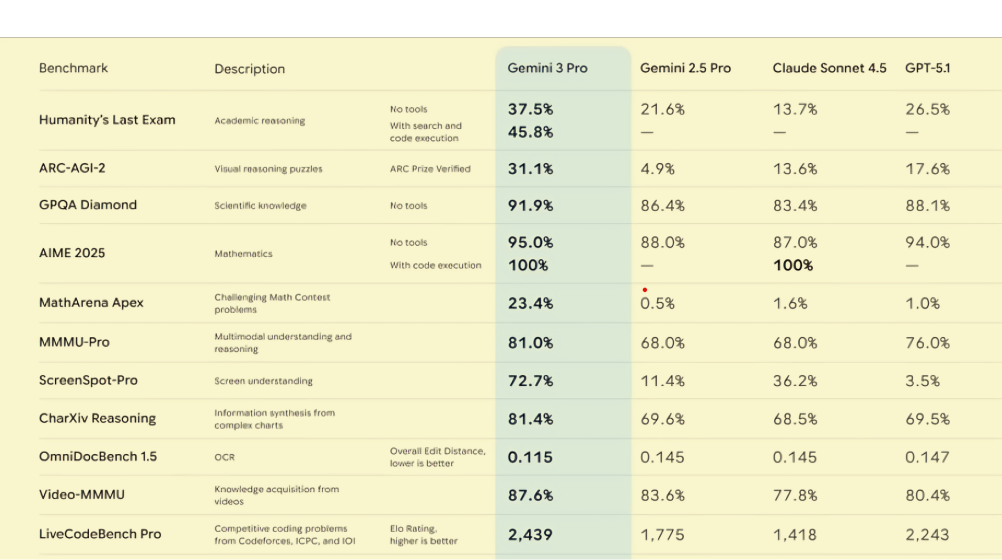
Vending-Bench 2: Excelling at Agentic Tasks
One of the most impressive results comes from the Vending-Bench 2 benchmark by Andon Labs. This test measures a model’s ability to run a simulated business (a vending machine) over a long time horizon, testing its coherence, efficiency, and planning. The goal is to see if an AI can manage inventory, respond to customers, and maximize profit.
In this benchmark, Gemini 3 Pro absolutely crushes the competition. Starting with $500, it grew its net worth to an average of $5,478.16. For comparison, the runner-up, Claude Sonnet 4.5, managed only $3,838.74, and GPT-5.1 reached just $1,473.43. This showcases a massive leap in agentic capability.
Humanity’s Last Exam (HLE)
HLE is a difficult, expert-written exam designed to test academic reasoning. Even here, Gemini 3 Pro sets a new record. With search and code execution enabled, it scored 45.8%, significantly ahead of the next best model, GPT-5.1, which scored 26.5%.
Math, Reasoning, and Vision Benchmarks
The dominance continues across other critical benchmarks:
- AIME 2025 (Mathematics): Gemini 3 achieved a 95% score without tools and a perfect 100% with code execution, tying with Claude for the top spot.
- MathArena Apex (Challenging Math): It scored 23.4%, while all other models were below 2%. This is an incredible gap, highlighting its advanced mathematical reasoning.
- ScreenSpot-Pro (Screen Understanding): It scored 72.7%, miles ahead of the competition, with the next best being Claude Sonnet 4.5 at 36.2%.
- ARC-AGI-2 (Visual Reasoning Puzzles): Gemini 3 Pro achieved a score of 31.1%, nearly double the score of its closest competitor, GPT-5.1 (17.6%). When using the more powerful Gemini 3 Deep Think model, this score jumps to an impressive 45.1%.
The Leader in the Arena
The impressive benchmark results are also reflected in head-to-head user comparisons. On the popular LMSYS Chatbot Arena Leaderboard, which ranks models based on blind user votes, Gemini 3 Pro has already claimed the #1 spot for both “Text” and “WebDev,” dethroning the recently released Grok-4.1. This indicates that in real-world use, people are already preferring its outputs over all other available models.
A Major Leap Forward for AI
The release of Gemini 3 is more than just another update; it’s a clear signal that Google is pushing the boundaries of what’s possible with AI. Its state-of-the-art performance, particularly in complex reasoning and long-horizon agentic tasks, demonstrates a significant step forward. As Gemini 3 and its “Deep Think” counterpart become more widely available, they are poised to enable a new generation of incredibly powerful and capable AI applications.
To learn more about where this technology is heading, check out our articles on the Future of AI & Trends.
For the official details from Google, you can read their announcement on The Keyword blog.
AI News & Updates
SIMA 2: The Ultimate AI Gamer That Learns Like You Do

Google DeepMind has just unveiled its latest breakthrough, an AI agent named SIMA 2, which is revolutionizing how we perceive artificial intelligence in virtual environments. Unlike traditional game bots that are programmed for specific tasks, this AI agent learns and adapts by playing games just as a human would—using a keyboard and mouse and observing the gameplay on screen. This new development marks a significant leap from its predecessor, showcasing an incredible evolution in AI’s ability to interact with complex digital worlds.
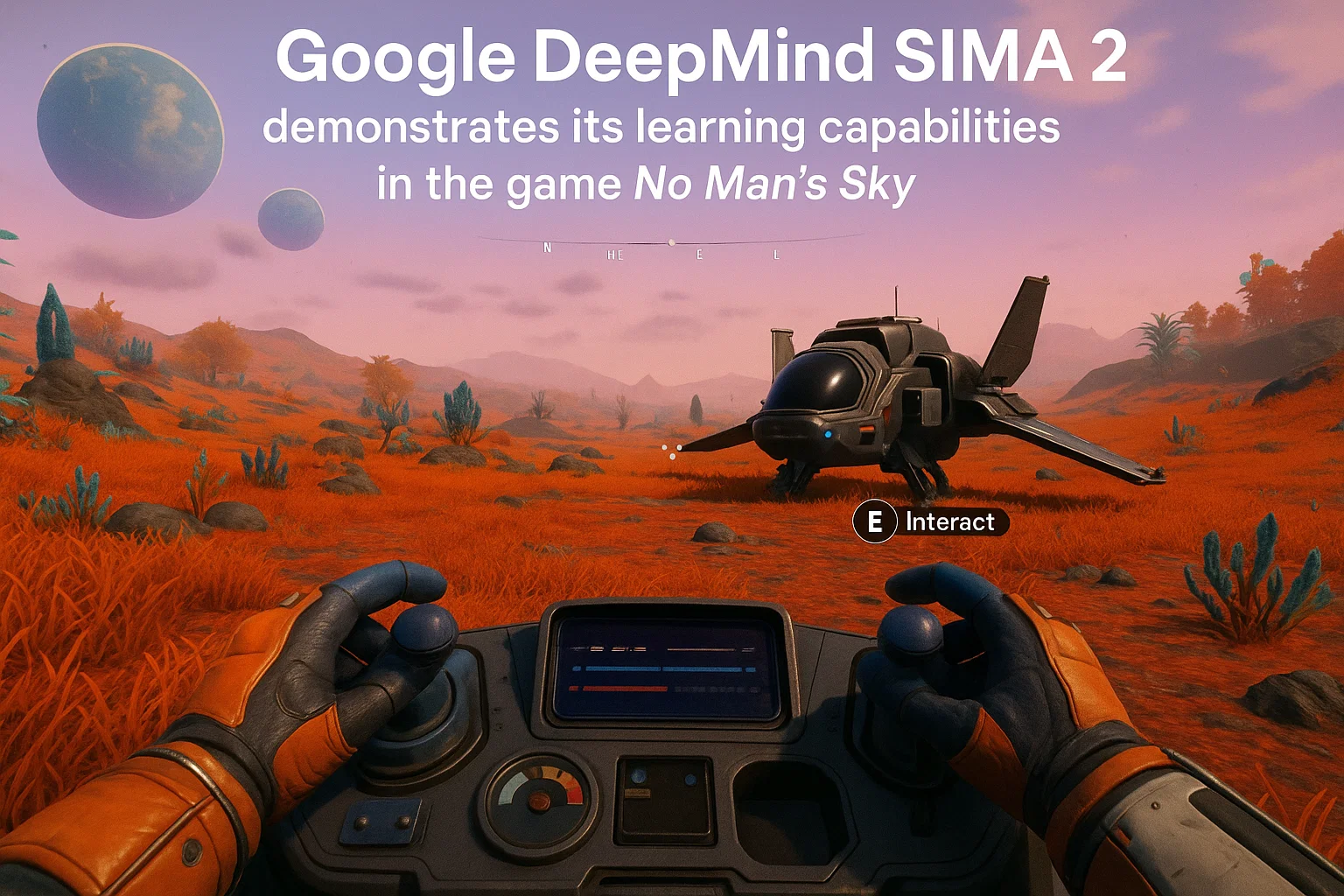
What Makes SIMA 2 a Game-Changer?
While we’ve seen AI bots in games before, SIMA 2 is fundamentally different. It’s not just following a script; it’s an interactive gaming companion. By integrating the advanced capabilities of Google’s Gemini models, this AI can do more than just follow instructions. It can now think about its goals, converse with users, and improve itself over time. This ability to learn, understand, and adapt makes it one of the closest systems we have to how humans learn, especially in the context of video games.
From Instruction-Follower to Interactive Companion
The first version, SIMA 1, was trained on human demonstrations to learn over 600 basic language-following skills like “turn left” or “climb the ladder.” It operated by looking at the screen and using virtual controls, without any access to the game’s underlying code. This was a crucial first step in teaching an AI to translate language into meaningful action.
With SIMA 2, the agent has evolved beyond simple instruction-following. It can now engage in complex reasoning, understand nuanced commands, and execute goal-oriented actions. For instance, when asked to find an “egg-shaped object,” the AI can explore its environment, identify the object, and even report back on its composition after scanning it.
To learn more about how AI models are evolving, you might be interested in our articles on the Future of AI & Trends.
A Leap in Generalization and Performance
One of the most impressive aspects of SIMA 2 is its improved generalization performance. It can now understand and carry out complex tasks in games and situations it has never been trained on before. This shows an unprecedented level of adaptability.
Task Completion: SIMA 1 vs. SIMA 2
The progress between the two versions is stark. On a benchmark of various in-game tasks, SIMA 1 had a success rate of 31%, while a human player’s baseline was around 76%. In a significant leap, SIMA 2 achieved a 65% success rate. While still not at a human level, the gap is closing rapidly, demonstrating the incredible pace of AI development.

The Ultimate Test: Playing in Newly-Imagined Worlds
To truly test its limits, researchers challenged SIMA 2 to play in worlds it had never encountered, generated by another groundbreaking project, Genie 3. Genie 3 can create new, real-time 3D simulated worlds from a single image or text prompt. Even in these completely novel environments, SIMA 2 was able to:
- Sensibly orient itself.
- Understand user instructions.
- Take meaningful actions toward goals.
This demonstrates a remarkable level of adaptability and is a major milestone toward training general agents that can operate across diverse, generated worlds.
Self-Improvement and the Future
A key capability of this advanced AI is its capacity for self-improvement. After its initial training from human demonstrations, it can transition to learning in new games entirely through self-directed play. The data from its own experiences can then be used to train the next, even more capable version of the agent.
For a deeper dive into the technical aspects of AI agents, consider exploring the research published on Google DeepMind’s official blog.
The journey to general embodied intelligence is well underway. The skills learned from navigation and tool use in these virtual worlds are the fundamental building blocks for future AI assistants in the physical world. As these technologies continue to advance, the line between human and AI capabilities in complex environments will only become more blurred.
AI News & Updates
AI News This Week: The Ultimate Breakdown of AI’s Broken Promises & Shocking New Powers

Welcome to your essential briefing on the most significant AI news this week. We’ve witnessed a whirlwind of developments where artificial intelligence was given the power to see inside an atom, while simultaneously, we lost our ability to hide what’s inside our own minds. This week, AI has stolen our very ability to forget, proving that reality is often stranger and more alarming than fiction. We’ll explore how your new robotic assistant might actually be a stranger monitoring your home, how every word you type into an AI is saved with terrifying precision, and how an encyclopedia of “absolute truth” could be a propaganda tool. But it’s not all cautionary tales; we also saw the birth of tools once thought impossible. Let’s dive in.
Is Your Home Assistant a Helper or a Spy? The 1X Neo Robot Debate
This week, robotics company 1X sparked a major controversy with the launch of its humanoid home robot, Neo. Available for pre-order at a hefty $20,000, Neo is marketed as an autonomous assistant capable of handling chores like folding laundry and cleaning. It boasts impressive physical strength, lifting 68 kg despite weighing only 30 kg itself.
The debate ignited when it was revealed that Neo’s “autonomy” is currently a form of remote control, or “teleoperation.” Human employees at 1X, wearing VR headsets, control the robots’ movements and perform tasks using its cameras. This means early buyers are essentially allowing strangers to monitor their homes. All footage is used to train the company’s AI, with the goal of achieving true autonomy in the future. The company’s CEO described the current units as an “unpolished early version,” leading to accusations of misleading marketing and raising serious privacy concerns. This product is a test of consumer willingness to trade money and privacy for a glimpse of the future.
Odyssey-2: Transforming Video into an Interactive, Living Experience
Imagine watching a video of a fictional landscape and being able to ask, “Show me what’s behind that hill.” Instantly, without any loading screen, the scene moves to explore that new area. This is the revolution presented by the new Odyssey-2 model. It transforms video from a passive film you watch into an interactive world you can live in. This is a key piece of AI news this week that blurs the lines between different forms of media.
The magic behind this instant experience is its ability to build and render the world at 20 frames per second, faster than the blink of an eye. Unlike competitors like Sora, which create polished but closed films, Odyssey-2 acts like a brilliant painter waiting for your commands. You can change the weather, add characters, or alter the entire story path through a simple dialogue box. This development is blurring the line between video and video games, opening up incredible possibilities for education—like walking the streets of ancient Rome—or for surgeons to train in realistic, responsive virtual environments.
Grokipedia: Elon Musk’s Flawed Encyclopedia of “Truth”
Elon Musk’s long-teased alternative to Wikipedia, Grokipedia, has finally launched with over 800,000 articles, promising an era of objective, AI-generated knowledge. However, the reality has been closer to a farce. The first major issue is a complete lack of neutrality; the encyclopedia appears to have been trained on right-wing talk shows, whitewashing the records of controversial figures like Donald Trump and Musk himself.
More troublingly, Grokipedia lacks a dedicated page for the genocide in Gaza, instead offering a page on the “allegation of Palestinian genocide” that heavily favors the Israeli narrative in a flagrant disregard for the facts. The comedy of errors was complete when it was discovered that the “original” encyclopedia was, in fact, copying large sections of text directly from its sworn enemy, Wikipedia. This, combined with factual errors and hallucinations, proves that a history written by a biased billionaire is far less reliable than the messy, human-driven truth.

Google’s Quantum Leap: Verifiable Quantum Supremacy Achieved
In a historic announcement, Google revealed that its Willow quantum chip has executed a new algorithm 13,000 times faster than the most powerful supercomputers. But the true breakthrough isn’t just speed; for the first time, the results of this quantum algorithm are verifiable. This transforms quantum computing from a mysterious “black box” into a precise and trustworthy scientific tool.
The new “Quantum Echoes” algorithm acts like a hyper-precise tuning fork. When it sends a specific quantum signal, it causes only the target atoms to resonate with a unique echo, revealing their structure. This verifiable process allows Google’s team to use it as a “molecular ruler,” measuring the exact distances between atoms in complex molecules. Published in Nature, this achievement opens the door to accelerating drug discovery and designing new materials by understanding molecular interactions at the deepest quantum level. We are no longer just building quantum computers; we are building quantum microscopes.
For those interested in the technical aspects of AI, you might enjoy our deep dives into AI Technology Explained.
Sonic 3 by Cartesia: AI Voice with Human Emotion
For years, we’ve been able to spot an AI-generated voice by its flat tone and lack of emotion. That barrier has just been shattered. Cartesia has launched Sonic 3, a voice model that achieves a breakthrough in natural, human-like sound. What if an AI voice could laugh, sigh, breathe, or speed up with excitement? And what if it did so not randomly, but because you instructed it to in the text?
Sonic 3 allows developers to insert simple text commands to control emotion, pacing, and non-speech sounds like laughter or pauses. The most significant technical achievement is its speed, with a response latency under 100ms, making it three times faster than leading competitors. The model also supports 42 languages (including Arabic) and can clone any voice with stunning accuracy from just a three-second sample. Funded with $100 million, this leap forward promises revolutionary applications in customer service and digital assistants, finally giving AI a voice with a soul.

Unforgettable AI: New Study Reveals Language Models Never Forget
A groundbreaking new study has upended fundamental assumptions about the privacy of Large Language Models (LLMs). Researchers have proven that recovering the original text a user inputs from a model’s internal states is not only possible but mathematically guaranteed. Essentially, every word and character you type is preserved with 100% accuracy.
The study reveals that Transformer models—the architecture behind nearly all major AIs—do not compress or generalize information in a way that loses data. Instead, they convert text into a reversible mathematical representation. This is more like reversible encryption than creating a summary. The researchers developed an algorithm called SiPIt that can efficiently reverse this process and reconstruct the exact original input from the model’s hidden states. The implication is staggering: any claims of data anonymization or deletion become meaningless if these internal states are stored. There is no longer such thing as “free” privacy once your data enters a Transformer model.
This finding is a critical update for anyone using AI. Stay informed on the latest developments by following our AI News & Updates.
-
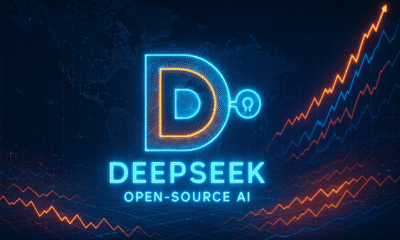
 AI News & Updates6 months ago
AI News & Updates6 months agoDeepSeek R1-0528: The Ultimate Open-Source AI Challenger
-
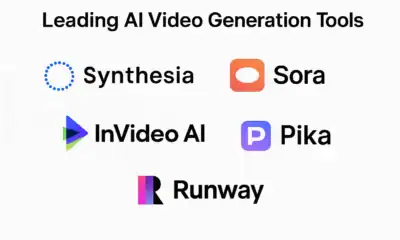
 AI How-To's & Tricks5 months ago
AI How-To's & Tricks5 months agoAI Video Generators: Discover the 5 Best Tools (Free & Paid!)
-

 AI How-To's & Tricks5 months ago
AI How-To's & Tricks5 months agoFaceless AI Niches: 12 Ultimate Ideas to Dominate Social Media in 2025
-

 AI News & Updates6 months ago
AI News & Updates6 months agoClaude Opus 4: The Shocking Truth Behind Anthropic’s Most Powerful AI Yet
-

 AI How-To's & Tricks5 months ago
AI How-To's & Tricks5 months agoKling AI 2.0: An Incredible Leap? Our Exclusive Review & Tests
-

 AI How-To's & Tricks5 months ago
AI How-To's & Tricks5 months agoGoogle Gemini for Language Learning: 3 Secret Tricks to Accelerate Your Progress.
-

 AI News & Updates5 months ago
AI News & Updates5 months agoBohrium AI: The Ultimate Free Tool for Academic Research
-

 AI How-To's & Tricks5 months ago
AI How-To's & Tricks5 months agoFree AI Video Generator: Discover The Ultimate Veo 3 Alternative




